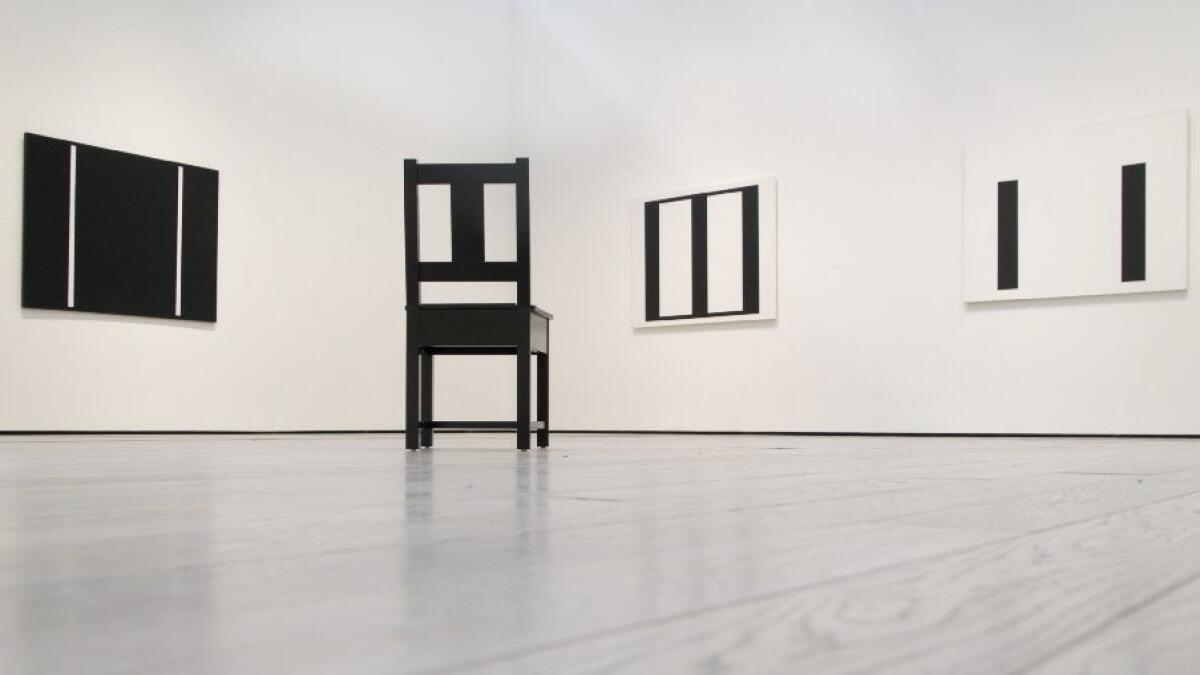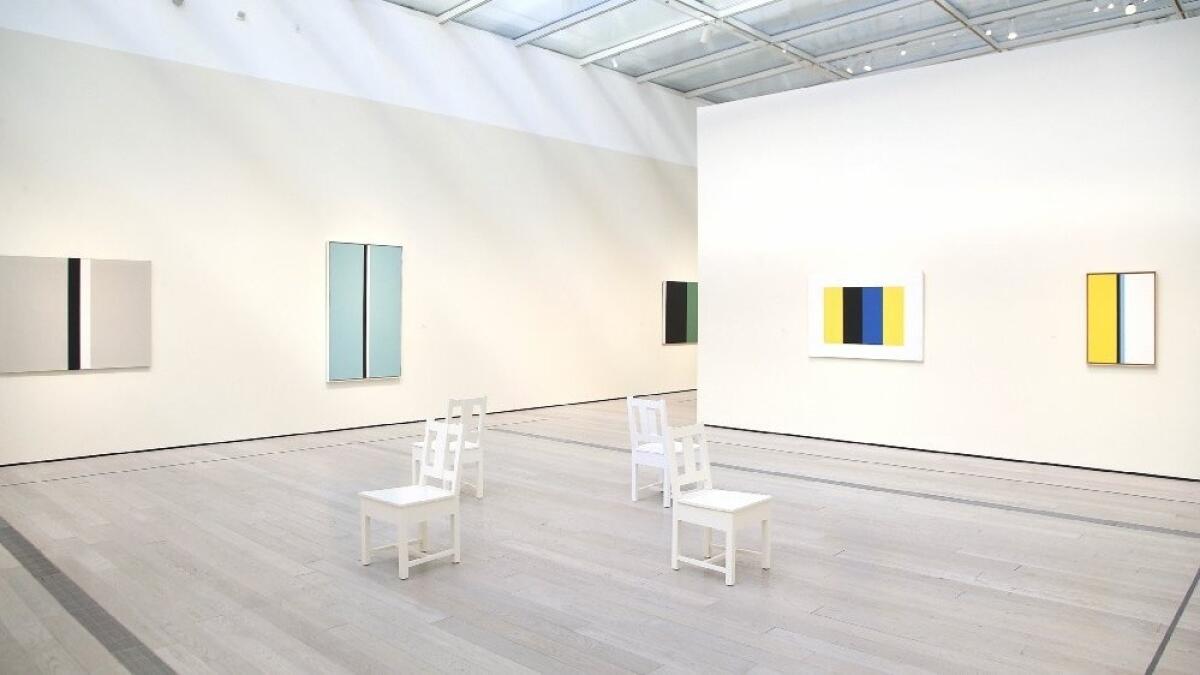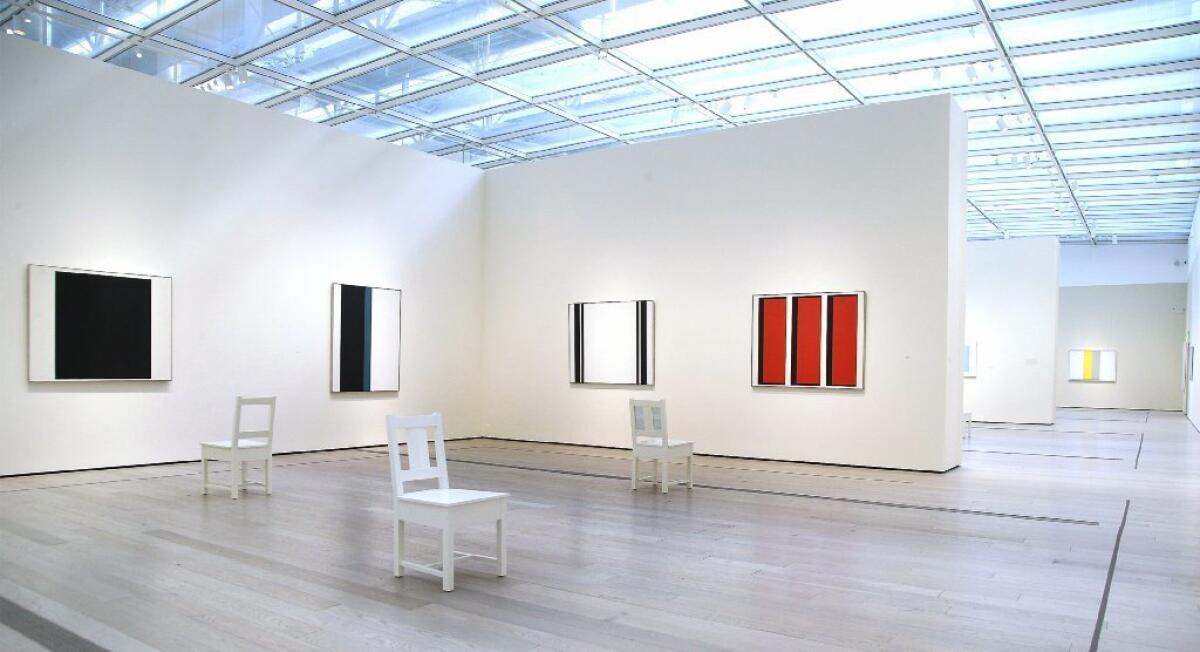Review: Go to LACMA for John McLaughlin, possibly the most important postwar artist you don’t know

- Share via
Once the canon of great artists is established, altering it is next to impossible.
Case in point: the introspective, quietly breathtaking art of John McLaughlin (1898-1976). His geometric abstract paintings are the subject of a gorgeous retrospective exhibition that opens Sunday at the Los Angeles County Museum of Art.
John who, you might ask?
McLaughlin is among the most profound avant-garde painters to work in the United States in the aftermath of the cataclysm that was World War II. He’s also Southern California’s first momentous postwar artist.
In paint on easel-size canvases or panels, McLaughlin’s perceptual abstractions took shape in essential ways between 1951 and 1952, and he refined and deepened his works’ resonance over the next quarter-century, never letting up. Born in the closing years of the 19th century, he laid the foundation for the environmentally scaled wonders of 1960s Light and Space art, which ranks as Los Angeles’ most original contribution to high culture at the end of the 20th century.
You could say that the global powerhouse L.A. has become for the production of new art today can be traced back to McLaughlin’s studio. Or, more precisely, to his modest house an hour south in Dana Point, where the self-taught artist began to devote his life to painting at the age of 48.
In those days, circa 1946, the L.A. avant-garde, both producers and consumers, could have fit into a proverbial phone booth. (Remember those?) Even in such limited circumstances, McLaughlin was something of a loner.
But his painting retrospective is the most moving and viscerally beautiful exhibition to be installed in BCAM, the museum’s contemporary galleries, since the building opened eight years ago. He had a few small museum shows during his lifetime, and a lovely posthumous survey was organized at the little Laguna Art Museum in 1996. But, with 52 paintings and 13 works on paper, this is the first time a major institution has mounted a proper, full-scale retrospective.

That such an indispensable painter didn’t merit one until 40 years after his death tells you all you need to know about how passed-over this brilliant artist has been. In fact, I’ve been waiting those same 40 years for it.
I had never heard of McLaughlin before moving from New York to Southern California in 1976, arriving just six weeks after he died. I saw a few lithographs at the Museum of Contemporary Art, San Diego, and later some paintings at the Nicholas Wilder Gallery in West Hollywood. I found the work to be riveting — but confounding.
His flat, uninflected rectangles of solid color bore superficial resemblance to 1960s Minimalist art, which they predated by nearly a decade. Yet his work isn’t merely the paint-as-paint literalism of that stripped-down aesthetic. It took a long while to grasp, but eventually the mystery began to unravel.
I had been schooled in Abstract Expressionism as ground zero for the postwar American avant-garde. McLaughlin began to paint just as its gestural extravagances and emotionally fraught chromatics began to coalesce into the New York School. In the wake of the Holocaust and Hiroshima, those artists stared straight into the void.
McLaughlin did too. But his void is different.
Radically so.
His void is not an abyss of social and spiritual terror in which interior narratives of worldly experience can be told, as it was for Jackson Pollock or Mark Rothko. Instead, his is the negative space that allows consciousness to blossom and manifest itself. Their art is about inviting us into their deep perception, while his is about inviting us into our own.
McLaughlin’s void is ma, the poetic space and interval between things that animate Japanese art.
McLaughlin’s work does reflect a reduced abstract geometry familiar in the Western avant-garde — especially Kazimir Malevich and Piet Mondrian. He knew their work, if only through magazine reproductions.
Utopianism, however, was not his goal. European abstraction provided a form for his art’s embodiment of Japanese aesthetic philosophy.
McLaughlin had looked at Japanese paintings since his childhood outside Boston. Son of a jurist on the state’s Superior Court, he was a regular visitor to the illustrious Japanese collection at the Museum of Fine Arts. His great-uncle was a collector, and he left his Japanese paintings to McLaughlin’s mother.
In 1928 McLaughlin married the grandniece of transcendentalist Ralph Waldo Emerson. Together they moved to Tokyo and then Beijing, staying for two years. Returning to Boston, he opened a gallery to deal in Japanese prints. When the war erupted, he was sent as a Japanese translator to California’s Manzanar internment camp, then shipped off for similar Navy work in India, Burma (now Myanmar) and China.
At war’s end, Bronze Star in hand, the couple settled in Dana Point. McLaughlin began to paint.
The LACMA show unfurls his mature work in five chronological galleries. A sixth and separate room has early studies, where he struggles to banish references from the visible world. These small paintings retain elements of Cubist still life.
Nearby are later works on construction paper. Before putting brush to canvas, he used collage to figure out scale, color and spatial relationships. As perhaps befits a self-taught painter working in general isolation, he bought his art supplies at the local Sears, Roebuck store.
And, boy, did he learn fast. Within six years, McLaughlin was the best painter in the small Southern California avant-garde, eclipsing the likes of Stanton Macdonald-Wright and Helen Lundeberg. His work rivals in imaginative depth and beauty any produced in the undisputed art capital of New York.
The hard edge between crisp, rectilinear color-shapes is like the sharpness at the boundary of a black shadow cast by an early afternoon California sun. Yet there is no hint of a recognizable image — no tree, stairway or café table, as there might be in an Ellsworth Kelly.
The rectangular internal shapes instead insist on the primacy of the painting’s own external shape, emphasizing its independence. The hard edges underscore the autonomous boundaries of the canvas.
Paint application is mostly smooth, uniform and flat, creating pure, clean abstractions. Black, white, gray and taupe are common, but so are limpid hues — sky blue, vivid yellow and crimson, plus an occasional green.
What these spare, stripped-down paintings do to your eyes is uncanny, undermining normal visual communication. Binary vision, the instinctive tendency for a viewer’s eyes to converge and create depth perception and the parallax vision that locates objects in space, is unplugged. The flat, bilateral compositions thwart that natural urge.
What’s left is a void — a rush of perceptual nothingness that nonetheless overflows with fulsome light and space. As he once explained, their subject is the viewer’s act of seeing.
McLaughlin’s best paintings are contemplative experiences, designed for solitary looking. Several times in the show, I wondered what the paintings might be like hanging in LACMA’s Japanese Pavilion, each installed within a tokonoma, the traditional domestic alcove where a single scroll or screen would be displayed for viewing.
To enhance this essential one-on-one relationship between a McLaughlin painting and its viewer, LACMA commissioned artist Roy McMakin to design a dozen sturdy, slat-back chairs. Built according to McLaughlin’s pictorial principles, they are dispersed throughout the galleries.

Each is slightly different, fusing American Shaker and Dutch De Stijl elements and painted in solid neutrals of ivory, cream or black. A reflection in a surreptitiously inserted mirror, glimpsed from the corner of your eye, will suddenly activate the space between painting and chair, or the layering of slats might echo a painting’s sequence of rectangles.
In one of the best, the chair back has no slats at all. Its horizontal, white-framed empty rectangle faces a vertical, black-painted rectangle hanging on the wall. A physical void confronts a perceptual void, and you lodge yourself into a comfortable seat between them.
The exhibition was assembled by LACMA curators Stephanie Barron and Lauren Bergman. It comes with an excellent catalog featuring contributions by them, as well as by curator Ilene Susan Fort, artist Tony Berlant, and critics Michael Duncan and Russell Ferguson.
The show will not travel. That’s a shame.
But it’s not for want of trying. LACMA offered the gorgeous McLaughlin retrospective to 39 museums, including majors like the Whitney in New York and the Chicago Art Institute; Boston’s Museum of Fine Arts, so important to shaping the artist’s aesthetic in his hometown; and important university galleries at Yale, UC Berkeley, Brandeis and Ohio State. Several are lenders to the show.
McLaughlin occupies the top tier of 20th century American art, yet none chose to host this first, full accounting of a critically important, under-regarded artist. That failure speaks of a profound void in the larger mission of America’s art museums, which continue to falter within our wealth-driven, celebrity-minded institutional culture.

------------
“John McLaughlin Paintings: Total Abstraction”
Where: LACMA, 5905 Wilshire Blvd., L.A.
When: Sunday-April 16; closed Wednesdays
Information: (323) 857-6000, www.lacma.org
Twitter: @KnightLAT
The biggest entertainment stories
Get our big stories about Hollywood, film, television, music, arts, culture and more right in your inbox as soon as they publish.
You may occasionally receive promotional content from the Los Angeles Times.








